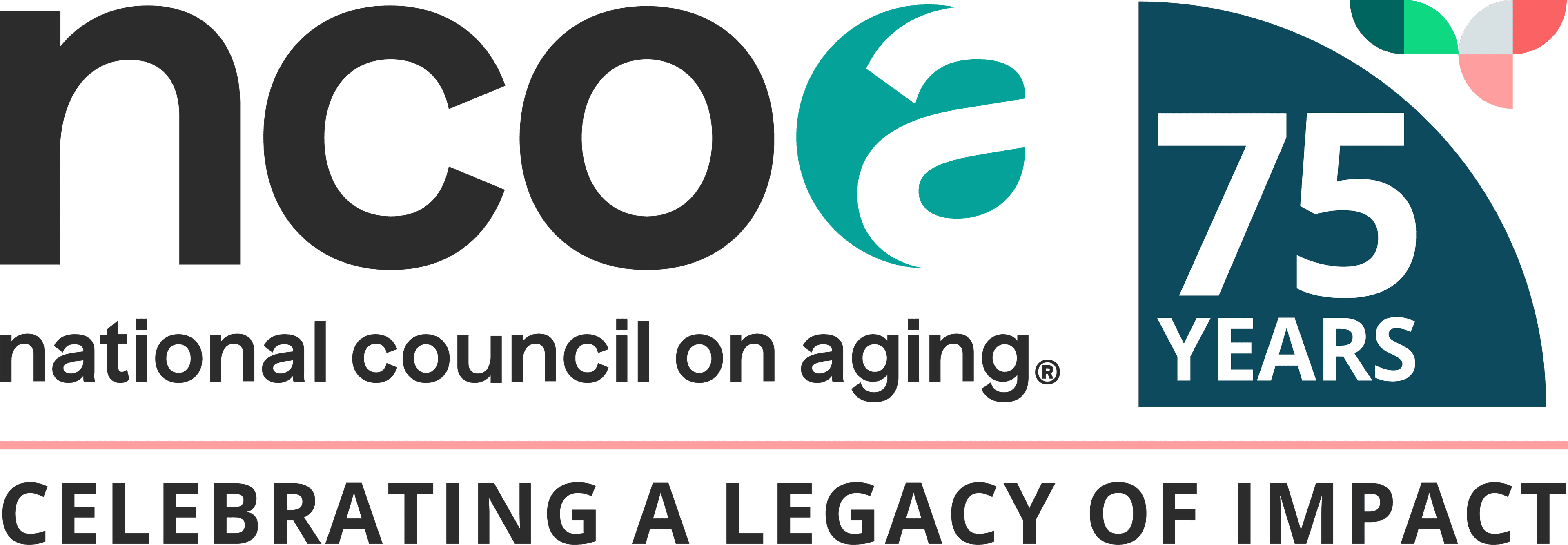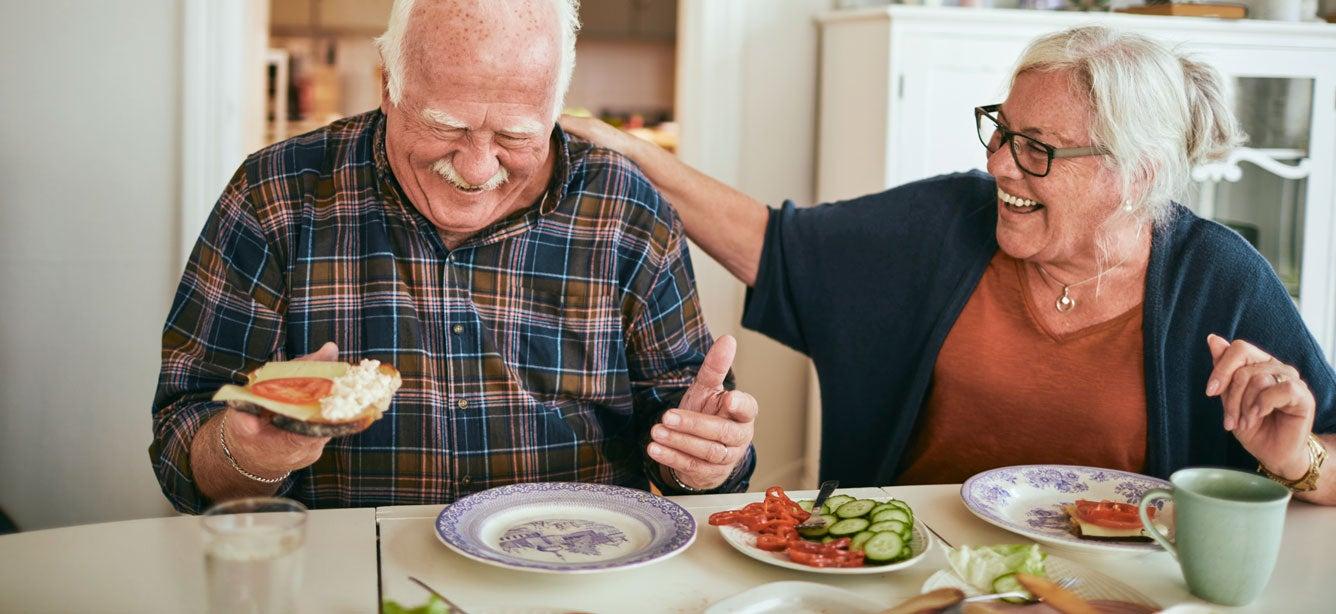
Related Topics
Good nutrition is one of the building blocks of aging well. It helps support our muscles, bones, and brain and various other body systems, allowing us to remain strong and independent for longer.
But as the years pass, even healthy older adults can experience a loss of appetite and other nutrition-related changes that lead to weight loss, muscle wasting, and nutrient deficiencies. This phenomenon is known as anorexia of aging—and it affects about a quarter of older people.1
For caregivers, changes in eating habits can be alarming to witness. But the more you know, the more you can do about it, says Gretchen Dueñas-Tanbonliong, MS, MPH, RDN, Associate Director of Health and Wellness at NCOA. “Understanding the barriers to eating well is the first step in helping the person you care for get adequate nourishment,” she explains.
Let’s look at four common nutrition challenges older adults face and practical ways you can help as a caregiver.
What are common nutritional problems in aging adults?
1. Taste changes and loss of appetite
What we experience as “flavor” is actually a mix of several basic tastes (salty, sweet, sour, savory, and bitter) combined with the smell of food and the sensations of temperature and texture. As we age, our sense of taste and smell may be blunted. This can make foods seem bland and unappealing, which in turn reduces the drive to eat. What’s more, certain medications—such as those for blood pressure, depression, and allergies—can further dull taste perception.
On top of this, declines in physical activity and metabolic rate can cause older adults to feel less hungry and consume fewer calories.
What caregivers can do when taste changes or loss of appetite happens
- Plan regular mealtimes and snacks, which helps our bodies trigger hunger signals. Try spacing meals further apart to stimulate appetite.
- Alternatively, try smaller, more frequent meals. This can feel less overwhelming to some people and make digestion more comfortable.
- Help your care recipient add movement into every day. Exercise burns calories, which naturally boosts sensations of hunger. It can also improve digestion and metabolism and even elevate mood.
- Enhance foods naturally with different spices and fresh herbs like thyme, dill, and rosemary. Add garlic, lemon, hot pepper, mustard, and vinegar to foods to improve taste without relying on excessive salt.
- Incorporate nostalgic or favorite foods that evoke pleasant memories and spark interest in eating. Blending vibrant colors (e.g., fruits and vegetables) with different textures can also make meals more enticing.
- Invite the person to take an active role in planning and/or preparing meals. This can help them feel more excited about mealtimes. It also gives your care recipient a sense of control over decisions that affect them. That’s important, since loss of independence is a common concern as we get older.
2. Dental issues and difficulty chewing or swallowing
Oral health problems—including tooth loss, ill-fitting dentures, and dry mouth—tend to make chewing painful or difficult. Medical conditions like Alzheimer’s disease and Parkinson’s disease can lead to dysphagia (difficulty swallowing), a syndrome affecting 10% to 33% of older adults.2
Any of these physical issues can increase the risk of choking or cause a person to avoid healthy foods like fruits, vegetables, and meats. Worse, they turn mealtimes into a source of stress and fear.
What caregivers can do for dental issues and difficulty chewing or swallowing
- Encourage regular dental checkups and ensure dentures fit well.
- Offer soft, moist foods like soups, stews, casseroles, mashed vegetables, yogurt, and smoothies.
- Cut foods into small, manageable pieces or puree meals when needed.
- Introduce oral nutrition supplements (ONS) such as nutritional drinks and shakes to boost calorie and nutrient intake, especially when chewing is a struggle or your care recipient is sensitive to certain textures. These beverages provide critical micro and macro nutrients while being easy to consume. According to Aimee Henrikson, MPH, RD, Senior Manager of Medical Affairs for Nestle's BOOST®, protein is one of the nutrients many older adults fall short on—and that impacts muscle health. For caregivers who need help identifying how much protein their care recipient needs, there are simple online tools, including this protein calculator from Nestle, that provide an estimate of recommended protein intake based on a few basic inputs.
- Offer hydrating foods like cucumbers, watermelon, and broth-based soups to help manage dry mouth while providing essential fluids.
- Mouth moisteners (in the form of sprays, mouthwashes, or lozenges) can serve as saliva substitutes for adults who have dry mouth. Sugar-free chewing gum helps stimulate salivary production in between meals.
- If swallowing is a concern, reach out to a speech therapist or registered dietitian-nutritionist (RDN) to learn about safe eating strategies.
The protein calculator listed above is for informational purposes only and is not a substitute for medical advice. This tool is intended for adults who are healthy and is not appropriate for children, pregnant or nursing women, competitive athletes, or people with specific diseases or medical conditions.
3. Chronic illnesses and medication side effects
Roughly 9 in 10 older Americans report having one or more chronic conditions like obesity, high blood pressure, high cholesterol, and diabetes.3 These conditions often come with dietary restrictions that limit food choices.
At the same time, medications used to treat chronic conditions can have side effects like nausea, dry mouth, constipation, and reduced appetite. Certain drugs may also affect nutrient absorption (e.g., diuretics, laxatives, ACE inhibitors).
Together, these factors can make it difficult to know what foods are safe and nutritious. Some older adults may eat less as a result, or avoid entire food groups altogether, setting the stage for nutrient deficiencies.
What caregivers can do about chronic illnesses and medication side effects
- Talk to your care recipient’s physician or a registered dietitian nutritionist (RDN) to build a flexible meal plan tailored to that person’s medical condition or other health needs.
- Is the person on medications known to interfere with nutrient absorption? Ask their doctor or pharmacist about a diet that keeps them well-nourished while ensuring their medicine stays safe and effective.
- Watch for any side effects when your care recipient is starting or changing medications (and report them to their provider).
- Prioritize nutrient-dense foods such as eggs, nut butters, beans, fish, avocados, and whole grains. These provide energy and key nutrients, even in smaller servings.
- Keep meals balanced yet flexible. This helps ensure the person feels comfortable but not overly restricted in their food choices.
4. Social and psychological barriers to healthy eating
Social isolation, grief, and mental health disorders like anxiety and depression can all affect an older person’s desire to eat. Others may face practical challenges like limited mobility, a tight budget, or lack of help with grocery shopping or daily meal preparation. These factors can lead to skipped meals or overreliance on unhealthy convenience foods.
What caregivers can do about social and psychological barriers to healthy eating
- Whenever possible, encourage shared meals with family and friends to make eating more enjoyable. Contact your care recipient’s local area agency on aging to ask about congregate meal programs, where older adults can dine together out in the community.
- If the person has trouble preparing food, look into home-delivered meal programs (e.g., Meals on Wheels). Online grocery delivery services are another option for having fresh food brought right to their door. Oral nutritional supplements can help fill nutritional gaps when food intake is reduced.
- Set up a pleasant, calming mealtime environment by playing soft music, using attractive plates, and turning off distractions like the TV.
- Is your care recipient showing signs of depression such as hopelessness, loss of interest in eating and other activities, or sleep issues? Talk to their doctor about therapy and other treatment options.
- If social isolation is a factor for the person you care for, contact their area agency on aging and ask about senior support services.
Caregivers are advocates for good nutrition
While aging can present nutritional obstacles for some older adults, they’re not insurmountable. The key is to stay vigilant for warning signs—such as unexplained weight loss, fatigue and muscle weakness, or avoidance of certain foods—and take steps to get ahead of them.
Dueñas-Tanbonliong points out that caregivers are major influencers in health and wellness. “Your impact is powerful. You can help that person find new joy and connection in mealtimes while getting the nutrition they need to live their best life.”
Sources
1. Agathe Daria Jadczak, et al. Anorexia of Aging - An Updated Short Review. The Journal of nutrition, health and aging. Found on the internet at https://www.sciencedirect.com/science/article/pii/S1279770723007352
2. Shanojan Thiyagalingam, et al. Dysphagia in Older Adults. Mayo Clinic Proceedings. February 2021. Found on the internet at https://pubmed.ncbi.nlm.nih.gov/33549267/
3. Kathleen B. Watson, PhD, et al. Trends in Multiple Chronic Conditions Among US Adults, By Life Stage, Behavioral Risk Factor Surveillance System, 2013–2023. Preventing Chronic Disease. April 17, 2025. Found on the internet at https://www.cdc.gov/pcd/issues/2025/24_0539.htm





